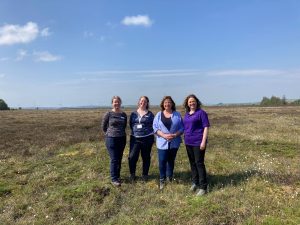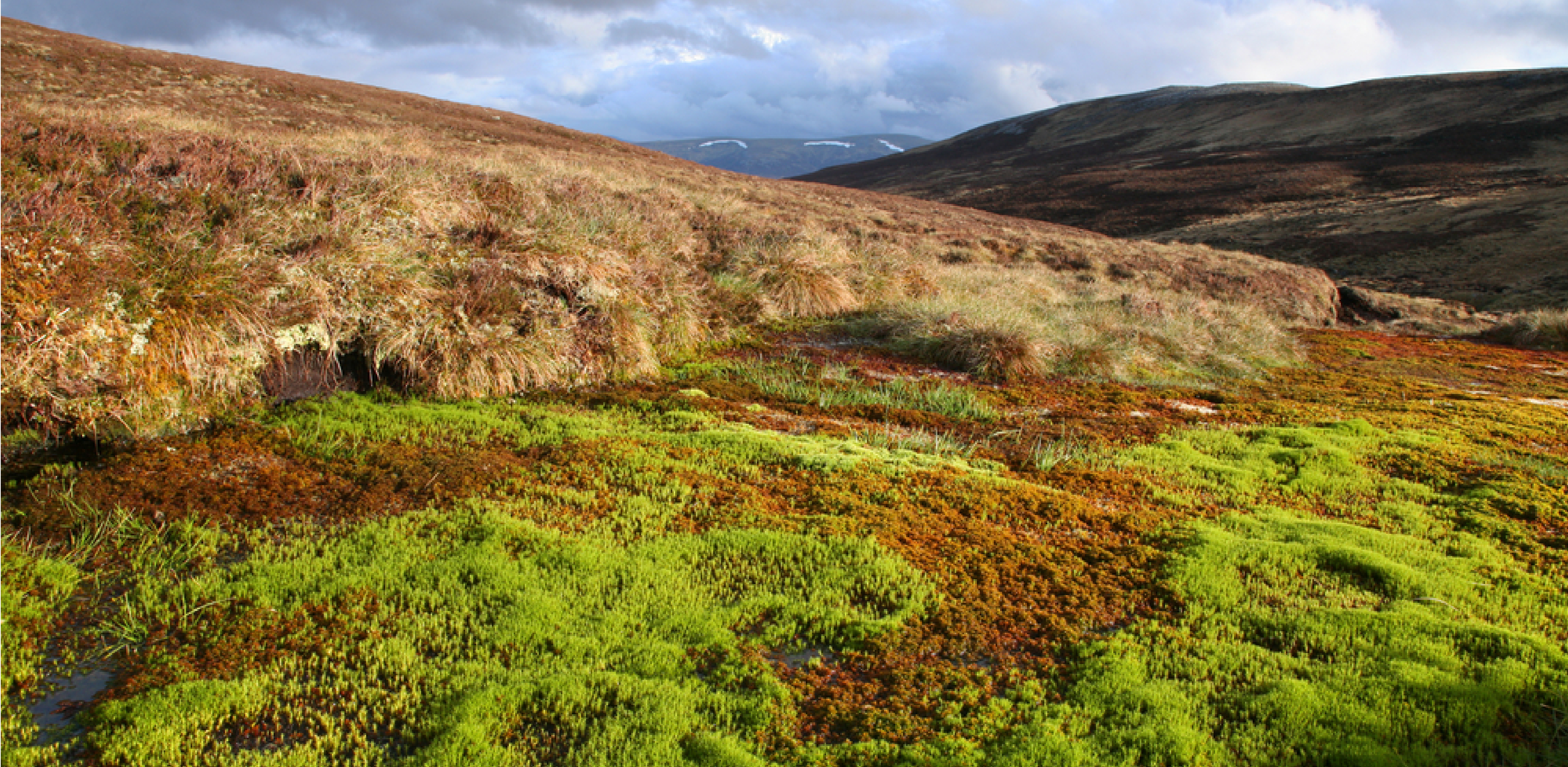Nature Champions visit to Black Moss Nature Reserve with Fiona Hyslop MSP
Have you heard of ‘Bog Day’? Maybe not, but every year the brilliance of bogs is celebrated around the world on the fourth Sunday in July, which this year is Sunday 28th July 2024. A perfect opportunity to celebrate blanket bogs with our very own Scottish Nature Champion for blanket bogs – Fiona Hyslop MSP. The Nature Champions initiative encourages Members of the Scottish Parliament to champion threatened species and priority habitats, raising awareness and promoting action to restore and safeguard Scotland’s environment. CIEEM (Chartered Institute of Ecology and Environmental Management) is co-hosting blanket bogs with ARC (Amphibian and Reptile Conservation).
Fiona has described blanket bogs as ‘extraordinary’ and Scotland’s blanket bogs really are extraordinary.
- In Scotland, blanket bogs cover around 1.8 million hectares, equating to 23% of our land area.
- Over 1.6 billion tonnes of carbon are stored in Scottish peatlands – a third of the carbon held in the Amazon rainforest, which is 250 times larger in area!
- The carbon stored in these soils is equivalent to over 180 years of the country’s greenhouse gas emissions at current emission rates. Healthy peatlands keep carbon locked up and continue to absorb more carbon. However, only around 20% of UK peatlands are in a natural, or semi-natural state due to human interventions and so are not only less effective in storing carbon, but actively release it.
- Blanket bogs are also incredibly important for biodiversity including upland breeding birds such as the Golden Plover, Invertebrates including Azure Hawker and Bog Sun-jumper Spider and reptiles such as Adders a beautiful, shy snake that gives birth to live young.
- Healthy blanket bogs act as giant sponges storing vast amounts of water, regulating, and slowing the movement of rainwater which helps to prevent downstream flooding.
Earlier in the year, we visited Black Moss Nature Reserve with Fiona in her constituency in West Lothian. Black Moss Nature Reserve is a lowland raised bog. Like blanket bogs, lowland raised bogs facilitate water flow regulation and store a massive amount of carbon. Lowland raised bogs are discreet, raised, dome-shaped masses of peat occupying former lakes or shallow depressions in the landscape. Black Moss is a heavily modified lowland raised bog. It has been subject to several industrial activities ranging from drainage, brick works, peat and coal extraction schemes and commercial tree planting.
Black Moss Nature Reserve is managed by West Lothian Council in partnership with the Green Action Trust and at our visit we heard from Callum McLaren, Ecology and Biodiversity Officer and Tracey Smith, Ranger with West Lothian Council and Louisa Maddison, Head of Operations at Green Action Trust about the ongoing restoration work funded by Peatland Action and Scottish Governments Nature Restoration Funding. This has included:
- Reprofiling work and ditch blocking (peat dams) along with some plastic dam installation.
- The removal of conifer trees on the northern section of the bog which were identified as being a threat to the restoration efforts. Conifer trees growing on the bog negatively affect its ability to retain water, leading it to dry out and making it less suitable for specialist bog species such as Sphagnum moss species, as well as locally uncommon Cranberry (a small flowering plant which scrambles over the surface of the moss carpet) and Round-leaved Sundew (a carnivorous plant). The issue of non-native conifers seeding into neighbouring habitats such as peatland in terms of carbon sequestration and biodiversity loss has been highlighted in a recent report on Invasive Non-native Species in Scotland: A Plan for Effective Action.
- Further removal of conifers with felled compartments being replanted with a native broadleaf species mix (Willow, Alder, Oak, Birch, Rowan and Hazel) which will help increase the sites biodiversity and reduce the risk of non-native trees seeding onto the adjacent raised bog habitat. More information here.

Pictured left to right: Annie Robinson, CIEEM, Louisa Maddison, Green Action Trust, Fiona Hyslop MSP, Rachael Cooper-Bohannon, ARC

Cottongrass
The site has been monitored as part of NatureScot’s study monitoring the success of Peatland Action. The results of the monitoring suggest the restoration works have been successful overall and that the average cover of indicator species has increased in all restoration and reference areas.
Over the years Black Moss Nature Reserve has had 387 species recorded. Most recently, to help inform management of the site, 229 plant species of plant were recorded in a 2023 survey. This included 10 species of sphagnum moss.
While we were visiting there was a carpet of the fluffy white heads of Cottongrass with the Round-leaved sundew, a carnivorous plant adapted to catch and digest small invertebrates spotted amongst the Sphagnum mosses.

Round-leaved sundew
Fiona Hyslop MSP, said:
“I was pleased to visit the Black Moss Nature Reserve, which is located in Armadale in my Constituency, to mark World Bog Day.
I am proud to be Scottish Environment Link’s Nature Champion for Scotland’s Extraordinary Blanket Bogs, which cover 23% of our land area.
Black Moss is managed by West Lothian Council in partnership with the Green Action Trust and is a lowland raised bog which facilitates water flow regulation and can store large amounts of carbon.
I was keen to hear about the restoration work at this site including dam installation, reprofiling work and the removal of conifer trees – which were a threat to the Bog. Working with the local Armadale community and people who use the area for walking and enjoying their local environment is also so important.
As we mark World Bog Day it is important to recognise the importance of bogs like this one in my Constituency for biodiversity, climate mitigation and adaptation and I am pleased to see that the restoration work here has been successful.”
Large-scale restoration is underway at many peatlands across Scotland via. In 2020, the Scottish Government announced significant annual investment in peatland restoration of more than £250 million up to 2030. Restoring peatlands is one of the most effective ways of locking in carbon; offering a clear nature-based solution to both the climate crisis and biodiversity loss. It requires continued investment, co-ordinated action at a regional and national scale and people with the skills needed to undertake the restoration. In addition, ecological and hydrological input is needed at all stages of the restoration with monitoring implemented to review and adjust management.
The upcoming Natural Environment Bill will introduce statutory targets for nature restoration. The establishment of legally binding nature targets is an important opportunity to drive recovery of crucial habitats like our peatlands.
More information about the threats to peatlands and the action needed can be found here.
